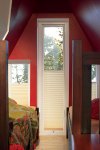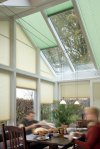Question:
Why wont my louvres, (slats, fabric, vanes) on my vertical blind won't rotate. Have I done something wrong?
Answer:This sometimes will happen if the louvres were originally hung onto the headrail whilst the hooks were in the closed position. Or you may have been operating your vertical blinds and the louvres have snagged on too one of the other blinds or perhaps an obstruction (ie a curtain or window handle). The best option is this:
You dont really need to take the louvres off the headrail, though sometimes this can help (ensure that when you reattach the louvres/slats make sure that they are all facing in the same direction!) Then turn the chain round until the hooks are in the open position, sometimes you may have to turn the chain until you hear a clicking nose, dont worry as this is perfectly ok for your blinds, keep on gently pulling until all the hooks are aligned the correct way. You may have to rotate the chain until it stops clicking, then rotate the opposite way. (You will notice that all of the hooks face the same direction. This means that when you rehang the louvres, you'll be able to see through them and out of your window. Your louvres should now rotate without any problems. But just remember that this may happen often due to any obstruction against your vertical blinds. You may have to ensure that you move any obstructions, or that you may have to operate one blind before the other. This commonly happens in square bay windows.
Question:
The louvres of my Vertical blind are not in line with each other. What should I do?
Answer:This is easily rectified. Pull the control chain until the slats are in the closed position, then gently force the chain by pulling on it, it should click as the carriages should be on a ratchet system, please also see above, once this has been completed they will realign. You may need to try doing this both ways. Don't worry if you hear a noise, that's perfectly normal. Please also see above.
Question:
The slats of my venetian blind are dirty. What should I do?
Answer:Well here we have the question that gets asked the most, if i could have 1pence for every time this has been asked i would be rich!!
If your slats on your venetian are dirty then they need to be cleaned, yes i hear you cry! What about these miracle cleaning things with fingers......Dont bother! The only easy way is by your hands with some soapy water, you may be able to take the blind down and put in the bath, if not then you will have to do it in situ...Yes it is a pain!!!!! Make sure that you only use a very mild detergent.
If you have wood venetian blinds, the only way you can clean them is with a slightly damp sponge, as the water may soak into the wood and over time may or will stain them.
Question:
The cords of my venetian blind are frayed or broken. What should I do?
Answer:The main problem with the cords being broken or frayed, is that it is getting a good colour match, so that it matches any other blinds or the matterials of your blind. What we normally ask for is a small sample of the cord, with the measurement, both width and drop, along with how many cords go into the headrail, this we then can calculate on how much cord is required.
Though if it is the ladder braid that has broken or frayed, this will mean stripping the whole blind down to replace the ladder braid (bits of cord that hold the slats at intervals, shaped like a ladder!) This is a bit more of problem, as it will take time to strip and rebuild, also the cord will have to be threaded through the slats, alternating from one side to the other on each section of the ladder braid, again though, we would need to see a sample of the ladder braid to colour match.
Colour matching is a real big problem, as over time, the colour of the cord, braid, ladder will fade.
Though all of this can be carried out by a compitent DIYer, it could possibly be recommended to ask a local blind company to carry out the repairs for you. As it can be hard if you dont know what your doing.
Question:
My pleated blind seems to be sagging. What should I do?
Answer:Normally this can be rectified by simply adjusting the tension of the blinds, as all it is, is that the guide wire is or should be in tension, all that has happend is that the blind requires retenstioning. This sometimes will be to be completed by some one who is fairly good at DIY.
You need to locate the lock nut or screw that holds the tensioning cords or even the cor, (word of warning, DONT LET THE CORD GO INTO THE HEADRAIL!) this is normally only one screw or nut, once you have located this, simply undo the fixing, you should note that your pleated blind may sag even more, dont worry as this is perfectly normal, then you will need to apply pressure on the cord by pulling it and you should note that the blind will be pulled up, once you have the desired tension, just tighten up the screw or nut. Though sometimes dependant on the type of blind you have, you may have to replace some of the springs that hold the tension, this problem may require a local blind company to rectify, though sometimes it is getting hold off the parts, it may even mean replacing all of the blind or blinds!!!
Question:
The VELUX blind has broken. What should I do?
Answer:Unfortuneatly this type of blind is unable to be repaired at present, as there are no spare parts available. Though you can contact Blindology Blinds, and we can sort out supplying you with a New VELUX blind, Velux blinds are guaranteed for 3 years. It is very very rare for a VELUX blind to be faulty within this period, if you do have a fault within this period, please contact the company that supplied your VELUX blind.
Question:
The chains or weights has broken on my vertical blind. What should I do?
Answer:This is a simple problem to overcome, all that you need is new stabilising chain or new weights, in both instances you would need to know the exact size of your louvres; 3.5" (89mm) or 5" (127mm). Then the amount of chain or weights required. The easiest way for the chain is to count how many slats or louvres you have also, this then would need to be multiplied by 2 to give you the amount of chain required.
The chain is simple to replace, it will just snap or pull of the weights. To replace the weights, just slide them out from one side, though remove the chain first!
To order the chains or weights is very simple, you can contact a local blind company or you can email Blindology blinds of Plymouth at info@blindology.co.uk, and we will endeavour to help you.
You can also view Blindology blinds of Plymouth's website, or view our FAQ section.


